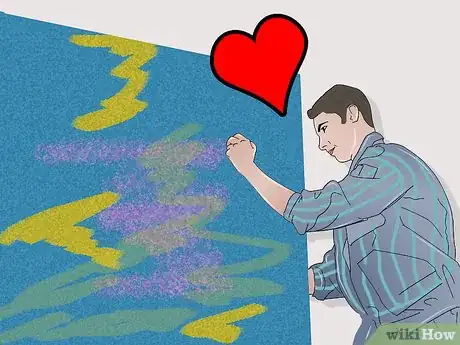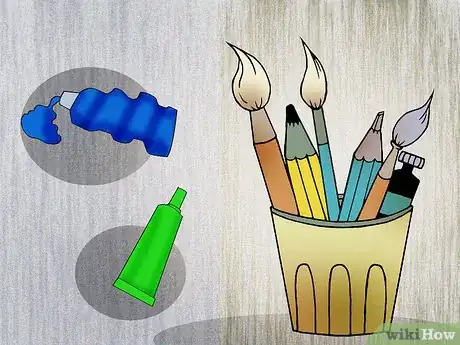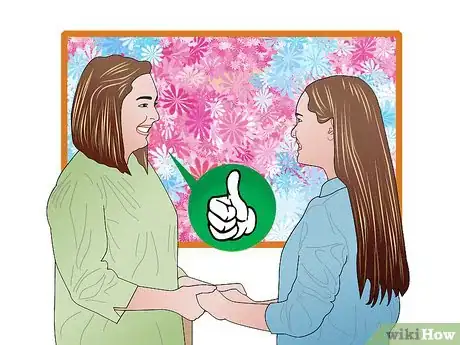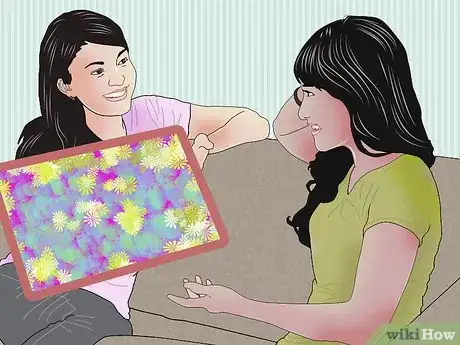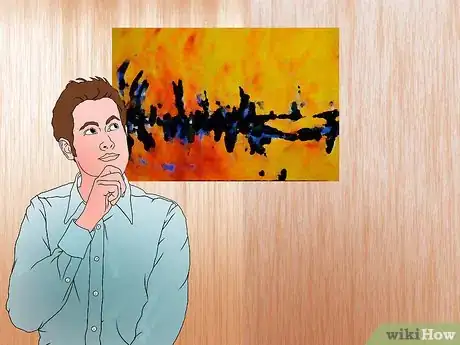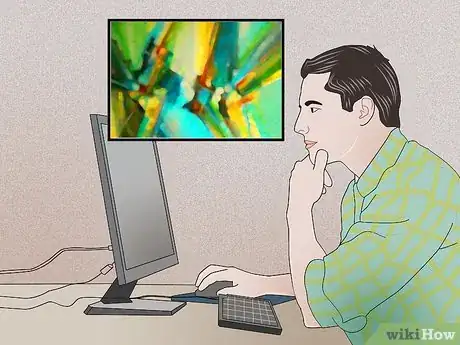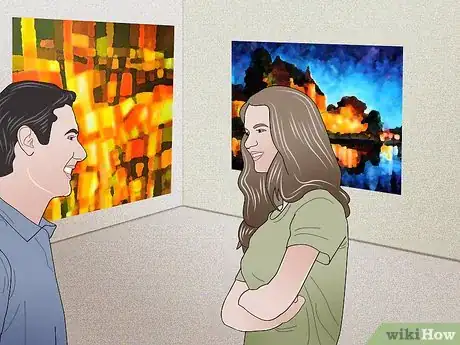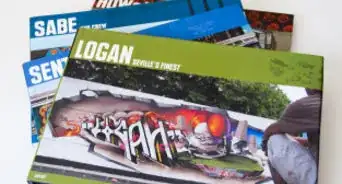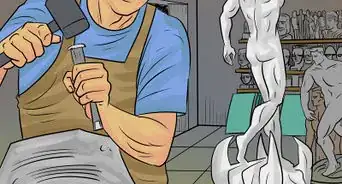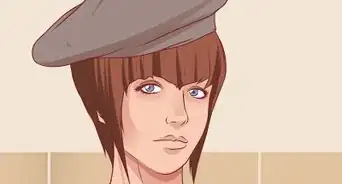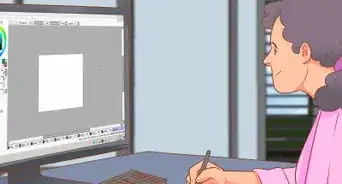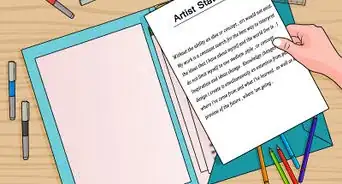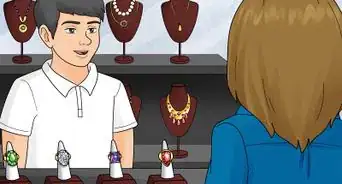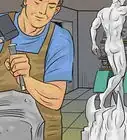This article was co-authored by Laura M. Johnson. Laura M. Johnson is a Mural Artist and the Owner of Laura Margo Murals & Custom Art in St. Paul, Minnesota. She has over five years of experience in the industry and has worked professionally across venture capital, communications, the arts, and beyond. She helps empower small and growing businesses to find their voices, share their stories, and grow their impact. Laura received her Master of Business Administration from the University of Minnesota - Carlson School of Management, and her Bachelors in Journalism and Communication Studies with a minor in Fine Arts from the University of Oregon.
wikiHow marks an article as reader-approved once it receives enough positive feedback. This article has 13 testimonials from our readers, earning it our reader-approved status.
This article has been viewed 477,071 times.
Your dream of becoming a famous artist may not be as far-fetched as it might seem: child prodigy Sir John Everett Millais was one of the founders of the Pre-Raphaelite[1] movement, and won a silver medal at the Society of Arts at age nine.[2] Also, Pablo Picasso, co-founder of the Cubist[3] movement, was regarded as a boy genius.[4] Even today, young artists such as Akiane Kramarik are heralded as prodigies.[5] If you have what it takes, your name may be destined to be remembered throughout the ages. Ready to learn how? Read on!
Steps
Building Your Skills
-
1Practice. Being called by the muse is a wonderful thing, without a doubt, but without the technical abilities to realize your vision, you won't get very far. Whatever your chosen medium or media, become an expert in every part of it.
- Set aside an hour or more each day to devote to nothing but practicing your technique.
- Focus especially on those areas that are the weakest for you, but build your strengths as well.
- Take advantage of the communities and resources that you can find. Artist supply manufacturers, and art stores themselves, often have free literature, tutorials, videos, and websites that are loaded with tips, techniques, and more.
- Some stores even offer weekend training seminars, where you can not only pick up some new skills, you'll also meet other artists.
-
2Work on the things you love. Choose one subject that is meaningful to you and that you want to be able to draw well.
- Start with a still life, or a photo that's yours, in public domain, or that you have permission to use. Draw or paint that same photo over and over, using different approaches—paint, pencil, abstract, realism—whatever moves you.
- Build up from easy subjects, like a rubber ball or a rectangular block, to more complicated, difficult subjects, like a rose, a clear glass marble or a shiny metal bowl. And try to get the details right: the curves of a petal, the clarity of the glass, or reflections so good that Escher would be impressed! Each of them will improve your ability to draw in general.
- Practice timed gesture drawing. Pick your subject, set your timer for two or three minutes, start drawing, then stop when the timer goes off, even if the drawing isn't finished.
- Set the timer again and start over. Doing 10 three minute drawings will give you more skill than taking half an hour to draw the same thing in detail.
Advertisement -
3Vary the art tools you use. Start off with a pencil, then go to charcoal, colored pencils, pastels, paint, whatever interests you. Never fear trying new tools or techniques.
- When trying an expensive new medium, visit Dick Blick or Jerry's Artarama and email them for samples. Many types of art suppliers make sample sized products or the company will send out just one stick or a small piece of the expensive paper or canvas for you to test before deciding what to buy.
- This gives you a chance to try it first and see if you like it. Try more than one brand—the samples are usually not the same color and you can find out which brand to invest in by those trials.
-
4Get critiqued by family and friends. Make it clear you want a real opinion, not just a biased, "I love you so everything you do is wonderful" opinion. If they think it's good, then you're on the right track! If they don't, you're still on the right track: if several people think your technique is great, but your subject matter leaves something to be desired, that's an opportunity for self-reflection and to learn something.
- Don't confuse critique with personal criticism, especially if the critic is somebody who is not interested in seeing you become an artist.
-
5Look outside your circle for opinions. Look for critique from people who draw better than you do. Make friends online with real artists whose work you admire. Compliment them and ask intelligent questions about their techniques. You'll rapidly find that many artists enjoy teaching beginners and will be happy to share what they've learned.
- As you learn more, reach out to those who are just starting. You will learn more every time you explain and demonstrate what you already know. It's very common for teachers to learn from their students!
-
6Learn to accept compliments gracefully. When friends and family members love everything you draw and think it's wonderful, or your mum was putting your childhood scribblings up on the fridge from the time you were two (and believes you'll be Picasso someday), relax and enjoy that as support.
- The better you get at art, the easier it is for people to compliment you and call you talented.
- Compliments can sometimes be critiques, and those are very valuable! Should an artist whose work you admire give you a compliment such as, "I love the colors in this," this means they are not only nice enough to compliment you on your work, but have taken the time to understand and appreciate the choices you made.
-
7Develop a strong personal style. Do this by learning to paint and draw your favorite subjects in all the ways that every painter you like best has done them. The more you learn technique and understand your own passions, the more your own style will emerge.
- Having a personal style is a combination of learning to draw and paint well in your favorite mediums while consistently paying the most attention to your favorite subjects.
- You will become a specialist, a "brand of one" at a certain intermediate level of competence. Mastering a subject and a medium comes later, at the point when you could do it easily without thinking at all about how you do it, yet always have consistent results.
-
8Be prolific. To get into a gallery, you should have a portfolio of up to a dozen of your best works, all of which have something in common, be it the subject or style, general size and level of skill.
- Make your work available in as many formats as possible, so that there are no barriers for interested gallery owners or art patrons to view your work.
Marketing Yourself
-
1Publish your work. The best way to become famous is to get known! The internet offers many avenues to be seen and promote artistic works, and in the information-loaded 21st century. It’s important to use all the tools at your disposal to build your name and reputation while staying true to yourself.
- Blog daily about your work, and include illustrations showing your process and a gallery to show (and/or sell) your finished works.
- Visit all the galleries in your area, and get to know the proprietors. If you're old enough, attend as many openings as possible, not to promote your own work—there will be time enough for that later—but to become a known artist in the community.
- Create a Facebook for your art, and encourage people to visit and like your page. Reach out to other artists through Facebook. Like visiting galleries, this will help place you in the community, and Facebook can reach well beyond your neighborhood.
- Tweet about art regularly. Your art, historical art, pop art, any art at all. The more you know about art, the more you'll be recognized as somebody worth paying attention to. At the same time, follow artists and galleries, and respond to their tweets. This will encourage more people—including gallery owners—to follow you.
- Create a Flickr account and post scans or photos of your art. It's an active community, and while you won't get a lot of helpful critique on Flickr, you will build your name recognition, and perhaps become online friends with some very talented artists.
- In today’s digital world, social media and a website are the easiest ways to put your artwork into the world and attract fans who care about what you do.
-
2Join fine art societies and enter contests. Start with student level contests at first and small local art contests.
- Teach workshops. This will help you not only get known as an artist, but also as an expert in your field.
- Build your skills until you can enter major national and international contests in your chosen medium.
- Enter juried art shows. Getting a painting into a juried art show is itself an achievement to put on your resume. When you have too many, shorten it by listing only the most important shows.
-
3Find a reliable art agent. Read up on art agencies and contact the agent's other clients. See if they are happy with the agent, or are generally discontented or feel as if they've been ripped off. Agents will market you and your work, and also represent you in contract negotiation. Make sure they are well-connected and good with contracts.
- You might also want to work with a reputable attorney who specializes in the art world. While an agent may know a bit about the law, their job is promotion. A lawyer's only job is knowing about the applicable law.
-
4Paint what you care about. If you don't care about the subject, it will show in your work. Many artists fall a little bit in love with their subject, whether it be a bowl of fruit or the artist's model.
- If you like expressing anger and dark emotions, study dark painters. If you like abstracts and splatter paintings, study them and do them—they take their own techniques and don't just happen because someone threw paint at a canvas and called it art.
- If you love wildlife and the outdoors, get a small portable painting kit and paint "en plein air" (outdoors) in your favorite places.
- Whatever your passion, find ways to capture that passion on the canvas.
-
5Keep growing as an artist. Being a true artist is a lifelong pursuit. When you've reached the level of fame to which you aspire, with plenty of money and acclaim, you will still want to look forward to something beyond that.
- Continuing to learn and invent, even after you are famous, will not just keep you on top of your game, focused on the future instead of putting your best years behind you.
- As your style grows and changes, older paintings you've done become more valuable. Collectors will be interested in the entire history of your life's work. Even the drawings you did as a child become valuable: what your mom stuck to the fridge has the seeds of your current success, so don't throw away earlier works.
Expert Q&A
-
QuestionHow do you get noticed in the local art community?
 Laura M. JohnsonLaura M. Johnson is a Mural Artist and the Owner of Laura Margo Murals & Custom Art in St. Paul, Minnesota. She has over five years of experience in the industry and has worked professionally across venture capital, communications, the arts, and beyond. She helps empower small and growing businesses to find their voices, share their stories, and grow their impact. Laura received her Master of Business Administration from the University of Minnesota - Carlson School of Management, and her Bachelors in Journalism and Communication Studies with a minor in Fine Arts from the University of Oregon.
Laura M. JohnsonLaura M. Johnson is a Mural Artist and the Owner of Laura Margo Murals & Custom Art in St. Paul, Minnesota. She has over five years of experience in the industry and has worked professionally across venture capital, communications, the arts, and beyond. She helps empower small and growing businesses to find their voices, share their stories, and grow their impact. Laura received her Master of Business Administration from the University of Minnesota - Carlson School of Management, and her Bachelors in Journalism and Communication Studies with a minor in Fine Arts from the University of Oregon.
Mural Artist Ask around and see if any local businesses are in need of illustrated posters, window painting, window design, and/or artwork for their walls—coffee shops in particular frequently showcase the work of local artists.
Ask around and see if any local businesses are in need of illustrated posters, window painting, window design, and/or artwork for their walls—coffee shops in particular frequently showcase the work of local artists. -
QuestionCan I still be an artist at the age of 15?
 Community AnswerBecoming a good artist takes time, and the earlier you start, the better. Start practicing and look up books of famous artists. Don't forget to learn art history, as it's the key to understanding the current state of the art world, whether you want to fit in or not.
Community AnswerBecoming a good artist takes time, and the earlier you start, the better. Start practicing and look up books of famous artists. Don't forget to learn art history, as it's the key to understanding the current state of the art world, whether you want to fit in or not. -
QuestionCan I still become a famous artist if I have epilepsy?
 Moonmodule1998Top AnswererOf course. Some notable famous artists with epilepsy include Leonardo Da Vinci, Vincent Van Gogh, and Michelangelo. Do a bit of online research to find other artists with epilepsy and the possible difficulties you could face. It's sometimes possible to contact artists directly through the internet or mail or other means, as long as they're alive of course, and you could potentially talk to a well-known artist with epilepsy about their experiences. It's definitely possible for you to be a great artist.
Moonmodule1998Top AnswererOf course. Some notable famous artists with epilepsy include Leonardo Da Vinci, Vincent Van Gogh, and Michelangelo. Do a bit of online research to find other artists with epilepsy and the possible difficulties you could face. It's sometimes possible to contact artists directly through the internet or mail or other means, as long as they're alive of course, and you could potentially talk to a well-known artist with epilepsy about their experiences. It's definitely possible for you to be a great artist.
Warnings
- Personal change can be frightening. When powerful feelings or uncertainty overtake you, you can use paint as your way of facing the fear and working through it.⧼thumbs_response⧽
- Relationships can become unstable if your romantic partner is jealous of the time, attention and emotion you devote to your art. This may or may not be a resolvable conflict. Try to be patient with your significant other, but if it doesn't work, find somebody more compatible who enjoys your being an artist.⧼thumbs_response⧽
- Never pay money up front to an agent. If they don't get your work, they do not deserve any money. If they ask, that's a big red flag that they're not to be trusted. Do a background check, and if the agent sounds too good to be true and talks you up like you're the next Picasso, it's likely he's too good to be true. Just walk away.⧼thumbs_response⧽
- One of the worst ways fame can destroy your life is if you decide to live out the stereotype of the drug/alcoholic spoiled-brat celebrity.⧼thumbs_response⧽
- Believe in yourself. You will also be changing your social identity from how you used to think of yourself into seeing yourself as an artist. Some people will get angry about this and reject your pursuit of art. They'll call it silly or self indulgent, they'll insult your work and tell you art isn't real work, call you a fraud, call you lazy, try to tell you to go back to being whoever they thought you were.⧼thumbs_response⧽
- Don’t undervalue your work—whether you’re compensated through money, an exchange of services, or direct access to your target market, there are lots of possibilities to get your work noticed and start validating your artist identity.⧼thumbs_response⧽
Things You'll Need
- Paper/Canvas
- Art supplies (paintbrushes, paint, pencils, etc.)
References
About This Article
To become a famous artist, practice every day so you can build your artistic skills and develop your own style. Create a variety of pieces that show your range and put together a strong portfolio to send to galleries. You can also blog about your work, post images online, and use social media to network and gain followers. You may want to consider hiring a reliable agent to help you market your work and negotiate contracts! For more tips on marketing yourself and gaining recognition, read on!

